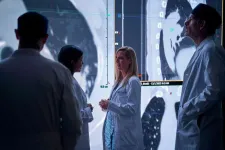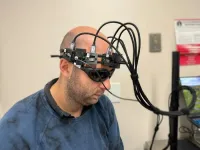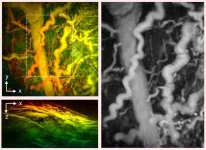(Press-News.org) WASHINGTON, September 30, 2024 — People with limited-stage small cell lung cancer may benefit from adding immunotherapy to chemoradiation, but not if both treatments are given at the same time, new research finds. The results suggest that the timing of when immunotherapy is given plays a key role in its ability to extend survival. Findings of the multi-institutional phase III trial, which also found that twice-daily radiation treatments offer greater survival benefits than once-daily treatment, will be presented today at the American Society for Radiation Oncology (ASTRO) Annual Meeting.
The research comes on the heels of a recent study showing immunotherapy given after radiation and chemotherapy are completed can increase overall survival for people with limited-stage small cell lung cancer. Researchers in this new study, the NRG Oncology/Alliance LU005 trial, wanted to test whether there would be a similar benefit when delivering the treatments at the same time.
“The introduction of immunotherapy marked the first significant breakthrough in treating small cell lung cancer treatment in decades. Now, we see that if you give immunotherapy concurrently with chemoradiation, it does not yield the same survival benefit as it does when we add it after standard treatment,” said Kristin Higgins, MD, the principal investigator of the trial and a radiation oncologist, professor and chief clinical officer at City of Hope Cancer Center in Atlanta.
“This seemingly small difference in the timing of when the drug is delivered has a very significant impact on the results. At the same time, we found that changing the way you deliver radiation — giving it twice daily — improved survival rates compared to the once daily approach.”
Lung cancer is the leading cause of cancer deaths for both women and men in the U.S. Small cell lung cancer, an especially aggressive form of the disease, accounts for 10% to 15% of all lung cancers. Standard treatment for patients with limited-stage disease, which has not spread outside the chest and is potentially curable, includes concurrent radiation therapy and chemotherapy. While treatments can be effective initially — the five-year overall survival rate is 30% — the cancer often recurs, and options for additional treatment have historically been limited.
Earlier this year, the landmark phase III ADRIATIC trial found adding a similar immunotherapy agent (durvalumab) six weeks after completion of chemoradiation reduced patients’ risk of death by 27%. ADRIATIC and similar trials showing a survival benefit from this new class of drugs were “the first therapeutic improvements for this ‘forgotten cancer’ in decades,” Dr. Higgins said. NRG Oncology/LU005 adds to this progress by shedding light on the importance of when treatment is delivered.
For the study, Dr. Higgins and her colleagues randomized 544 patients at centers across the U.S. (n=500) and Japan (n=44) to receive standard chemoradiation with or without atezolizumab immunotherapy. All patients received radiation therapy either twice daily to a total dose of 45 Gy (47.2% of participants) or once daily to a dose of 66 Gy, as well as four cycles of concurrent chemotherapy. For patients on the experimental arm, atezolizumab was also given every three weeks beginning at the start of radiation, for a maximum of one year. Prophylactic cranial irradiation was prescribed at the discretion of the investigator for patients with a complete or near-complete response to chemoradiation. Median follow-up for this second planned interim analysis was 21 months.
Contrary to expectations, concurrent treatment with atezolizumab and chemoradiation did not improve survival rates compared to standard care. After one year, overall survival for patients receiving chemoradiation alone was 82.6%, compared to 80.2% with concurrent chemoradiation and atezolizumab. At two years post-treatment, the rates were 62.9% and 58.6%, respectively, and after three years, 50.3% and 44.7%. Median overall survival for patients on the standard treatment arm was 39.5 months, compared to 33.1 months for those who also received immunotherapy (HR=1.1, 95% CI: 11.3-18.2).
The lack of survival benefit when giving immunotherapy together with chemoradiation, rather than after radiation is completed, indicates that the activity of this type of immunotherapy is reduced when given simultaneously with thoracic radiation, likely due to the inherent immunosuppressive effects of radiation, Dr. Higgins said.
“We know that radiation suppresses the immune system to a certain degree in the immediate sense, and immunotherapy relies on the immune system to be effective,” she explained. “Adding these drugs after you give radiation can make the immunotherapy more potent, but you have to allow the immune system time to recover to really see the two work well together.”
Adding concurrent immunotherapy to chemoradiation also did not improve progression free survival (median 11.5 months with atezolizumab vs. 12.0 months without) or distant metastasis free survival (13.2 vs. 16.8 months, respectively).
“Sometimes, if you give too much therapy at the same time, it actually yields worse outcomes,” Dr. Higgins said. “And this trial demonstrated that. But at the same time, we did see that changing the way you give radiation can help.”
There was a benefit to giving radiation twice daily over giving it once daily, regardless of study arm. In both groups, patients treated twice daily lived longer on average; median overall survival for those treated twice daily was 35.4 months, compared to 28.3 months for people treated once per day (HR=1.44, 95% CI: 1.10-1.89).
Most radiation oncologists in the U.S. favor the once-daily approach because it presents fewer logistical challenges for treatment delivery, Dr. Higgins said, but these data suggest a potential need to re-evaluate current practice patterns.
“While this wasn't the primary endpoint of the study, we see clearly that patients receiving radiation for small cell lung cancer do better when you treat them twice daily,” she explained. “Many doctors and patients may find twice daily radiation more cumbersome, but these data show giving radiation in a more compact way is beneficial for survival.”
###
Attribution to the American Society for Radiation Oncology (ASTRO) Annual Meeting is requested in all coverage.
Study/Presentation Details
Abstract LBA 02: Concurrent chemoradiation +/- atezolizumab (atezo) in limited-stage small cell lung cancer (LS-SCLC): Results of NRG Oncology/Alliance LU005
News Briefing: Monday, September 30, 10:00 a.m. Eastern time. Details here. Register here.
Scientific Presentation: Monday, September 30, 1:30 p.m. Eastern time, Walter E. Washington Convention Center. Email press@astro.org to access the livestream or recording.
This project was supported by grants U10CA180868 (NRG Oncology Operations), U10CA180822 (NRG Oncology SDMC), UG1CA189867 (NCORP), U24CA196067 (NRG Specimen Bank), U24CA180803 (IROC) from the National Cancer Institute and Genentech, member of the Roche Group. ClinicalTrials.gov Identifier: NRG-LU005, NCT03811002
ABOUT ASTRO
The American Society for Radiation Oncology (ASTRO) is the largest radiation oncology society in the world, with more than 10,000 members who are physicians, nurses, biologists, physicists, radiation therapists, dosimetrists and other health care professionals who specialize in treating patients with radiation therapies. Radiation therapy contributes to 40% of global cancer cures, and more than a million Americans receive radiation treatments for cancer each year. For information on radiation therapy, visit RTAnswers.org. To learn more about ASTRO, visit our website and follow us on social media.
END
Timing matters when adding immunotherapy to chemoradiation for patients with limited-stage small cell lung cancer
International phase III trial also finds twice daily radiation extends survival over once daily treatment
2024-09-30
ELSE PRESS RELEASES FROM THIS DATE:
Existing standard chemoradiation superior to deintensification approaches for HPV-related oropharyngeal cancer
2024-09-30
WASHINGTON, September 30, 2024 — Researchers looking to de-intensify radiation treatments for people with early-stage, HPV-associated oropharyngeal cancer to prevent long-term side effects halted a large, randomized phase II/III trial after patients in the control arm reached a record high, two-year progression-free survival rate of 98%. De-intensified treatments involving a lower radiation dose and immunotherapy in place of chemotherapy did not perform as well as the more rigorous chemoradiation approach. Findings of the NRG Oncology HN005 trial will be presented today at the American Society for Radiation Oncology (ASTRO) Annual ...
CAR-T safe and effective on an outpatient basis in community hospitals
2024-09-30
(WASHINGTON – September 30, 2024) In the largest prospective study to date examining the use of chimeric antigen receptor (CAR)-T therapy in a community setting on an outpatient basis, patients with relapsed or refractory large B-cell lymphoma (LBCL) responded well to treatment with few serious side effects, according to results published today in Blood Advances.
LBCL is a cancer affecting B lymphocytes, a type of white blood cell. It can progress rapidly and is fatal if untreated, although most forms of LBCL respond well to standard ...
City of Hope to present leading-edge radiotherapy treatments for people with lung, genitourinary and blood cancers at the American Society for Radiation Oncology Annual Meeting
2024-09-30
LOS ANGELES — City of Hope®, one of the largest and most advanced cancer research and treatment organizations in the U.S. and ranked among the nation’s top 5 cancer centers by U.S. News & World Report, is part of today’s press conference program at the American Society for Radiation Oncology (ASTRO) Annual Meeting, where a renowned City of Hope radiation oncologist will present phase 3 clinical trial data showing that people with limited-stage small cell lung cancer may benefit from adding immunotherapy to chemoradiation, but not if both treatments are given at the same time. The results suggest that the timing of when immunotherapy is given plays a key role in its ...
A new and unique fusion reactor comes together with PPPL's contributions
2024-09-30
Like atoms coming together to release their power, fusion researchers worldwide are joining forces to solve the world’s energy crisis. Harnessing the power of fusing plasma as a reliable energy source for the power grid is no easy task, requiring global contributions.
The Princeton Plasma Physics Laboratory (PPPL) — a U.S. national laboratory funded by the Department of Energy (DOE) — is leading several efforts on this front, including collaborating on the design and development of a new fusion device at the University of Seville in Spain. The SMall Aspect Ratio Tokamak (SMART) strongly ...
Reduced risk of serious cardiovascular disease after COVID vaccination
2024-09-30
People who have been fully vaccinated against COVID-19 have a significantly lower risk of developing more severe cardiovascular conditions linked to COVID-19 infection, according to a nationwide study at the University of Gothenburg. At the same time, some cardiovascular effects are seen after individual doses of the vaccine.
The COVID-19 vaccine aims to reduce complications and overall mortality from the disease. At the same time, some cardiovascular effects have been seen after individual doses of the vaccine. A rare acute side effect is inflammation of the cardiac muscle or the pericardium in young men following mRNA vaccination. In terms of other cardiovascular ...
New laser-based headset can measure blood flow, assess risk of stroke
2024-09-30
When physicians want to know more about a patient’s risk of cardiovascular disease, they can order a cardiac stress test. But when it comes to risk of stroke, there is no equivalent scalable and cost-effective test of the brain’s function to help physicians counsel patients on their potential risk. A questionnaire that asks patients about contributing risk factors is currently the best tool for estimating such risk.
Now a team of engineers and scientists from Caltech and the Keck School ...
Researchers close in on understanding possible cause of Alzheimer’s disease
2024-09-30
CLEVELAND—With a four-year, $3.3 million grant from the National Institutes of Health (NIH), researchers from Case Western Reserve University will study whether certain brain proteins may play a role in the development of Alzheimer’s disease.
Alzheimer’s disease is a brain disorder that slowly destroys memory and thinking skills. According to the Alzheimer’s Association, nearly 7 million Americans 65 and older are living with the disease and there are more deaths from Alzheimer’s than breast and prostate cancer combined.
Previous research has ...
New synthesis strategy could speed up PFAS decontamination
2024-09-30
HOUSTON – (Sept. 30, 2024) – Rice University engineers have developed an innovative way to make covalent organic frameworks (COFs), special materials that can be used to trap gases, filter water and speed up chemical reactions. COFs have the potential to address significant environmental challenges, including energy storage and pollution control. An example of that is their potential use in the decontamination of “forever chemicals” or per- and polyfluoroalkyl substances (PFAS).
Rice chemical engineer Rafael Verduzco and his team have described a new way to synthesize high-quality ...
COVID-19 linked to increased risk of acute kidney disorders: New study reveals time-varying effects
2024-09-30
Researchers from West China Hospital, Sichuan University, have conducted a study revealing a significant association between COVID-19 and acute kidney disorders (AKD), including acute kidney injury (AKI), that varies over time. The study, led by Dr. Li Chunyang and Dr. Zeng Xiaoxi from the West China Biomedical Big Data Center, was recently published in the journal Health Data Science.
COVID-19, known for its impact on the respiratory system, also affects other organs, including the kidneys. The study aimed to investigate the time-dependent effects of COVID-19 on acute kidney disorders. Using data from the ...
Medical imaging breakthrough could transform cancer and arthritis diagnosis
2024-09-30
A new hand-held scanner developed by UCL researchers can generate highly detailed 3D photoacoustic images in just seconds, paving the way for their use in a clinical setting for the first time and offering the potential for earlier disease diagnosis.
In the study, published in Nature Biomedical Engineering, the team show their technology can deliver photoacoustic tomography (PAT) imaging scans to doctors in real time, providing them with accurate and intricate images of blood vessels, helping inform patient care.
Photoacoustic ...
LAST 30 PRESS RELEASES:
First Editorial of 2026: Resisting AI slop
Joint ground- and space-based observations reveal Saturn-mass rogue planet
Inheritable genetic variant offers protection against blood cancer risk and progression
Pigs settled Pacific islands alongside early human voyagers
A Coral reef’s daily pulse reshapes microbes in surrounding waters
EAST Tokamak experiments exceed plasma density limit, offering new approach to fusion ignition
Groundbreaking discovery reveals Africa’s oldest cremation pyre and complex ritual practices
First breathing ‘lung-on-chip’ developed using genetically identical cells
How people moved pigs across the Pacific
Interaction of climate change and human activity and its impact on plant diversity in Qinghai-Tibet plateau
From addressing uncertainty to national strategy: an interpretation of Professor Lim Siong Guan’s views
Clinical trials on AI language model use in digestive healthcare
Scientists improve robotic visual–inertial trajectory localization accuracy using cross-modal interaction and selection techniques
Correlation between cancer cachexia and immune-related adverse events in HCC
Human adipose tissue: a new source for functional organoids
Metro lines double as freight highways during off-peak hours, Beijing study shows
Biomedical functions and applications of nanomaterials in tumor diagnosis and treatment: perspectives from ophthalmic oncology
3D imaging unveils how passivation improves perovskite solar cell performance
Enriching framework Al sites in 8-membered rings of Cu-SSZ-39 zeolite to enhance low-temperature ammonia selective catalytic reduction performance
AI-powered RNA drug development: a new frontier in therapeutics
Decoupling the HOR enhancement on PtRu: Dynamically matching interfacial water to reaction coordinates
Sulfur isn’t poisonous when it synergistically acts with phosphine in olefins hydroformylation
URI researchers uncover molecular mechanisms behind speciation in corals
Chitin based carbon aerogel offers a cleaner way to store thermal energy
Tracing hidden sources of nitrate pollution in rapidly changing rural urban landscapes
Viruses on plastic pollution may quietly accelerate the spread of antibiotic resistance
Three UH Rainbow Babies & Children’s faculty elected to prestigious American Pediatric Society
Tunnel resilience models unveiled to aid post-earthquake recovery
Satellite communication systems: the future of 5G/6G connectivity
Space computing power networks: a new frontier for satellite technologies
[Press-News.org] Timing matters when adding immunotherapy to chemoradiation for patients with limited-stage small cell lung cancerInternational phase III trial also finds twice daily radiation extends survival over once daily treatment







